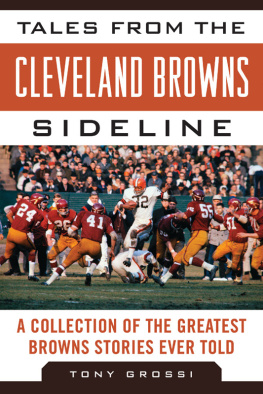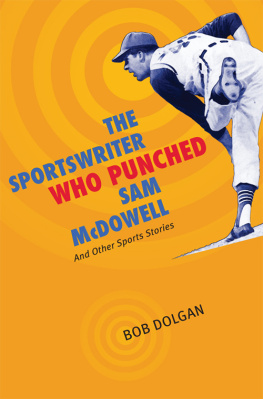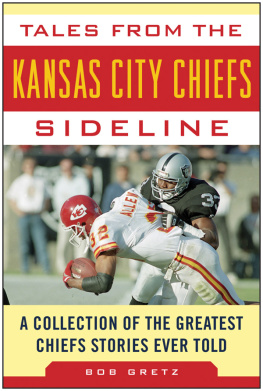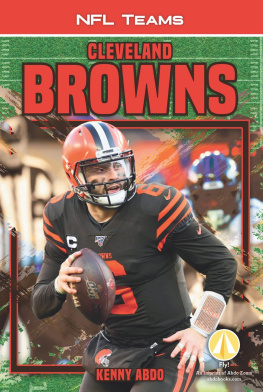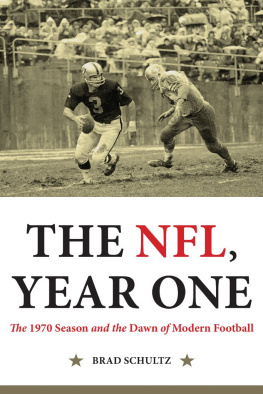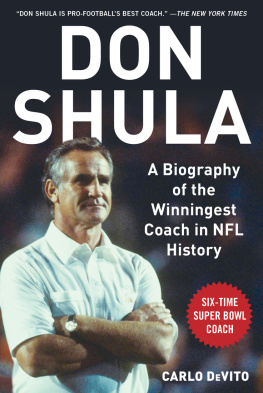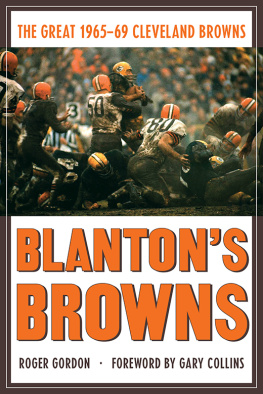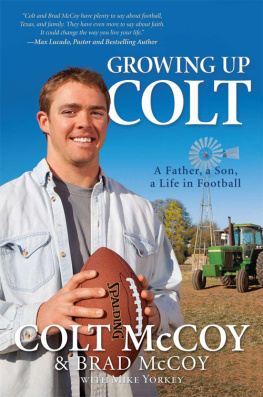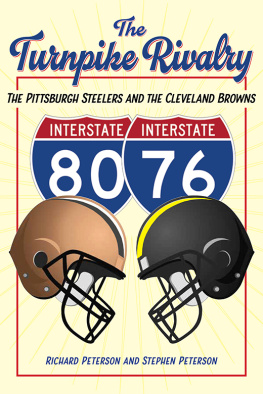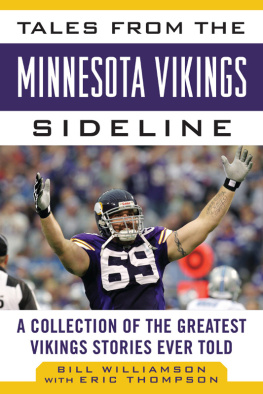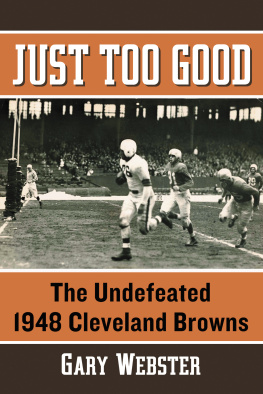TALES FROM THE
CLEVELAND BROWNS
SIDELINE
A COLLECTION OF THE GREATEST
BROWNS STORIES EVER TOLD
TDNY GROSSI

Copyright 2004, 2012 Tony Grossi
All Rights Reserved. No part of this book may be reproduced in any manner without the express written consent of the publisher, except in the case of brief excerpts in critical reviews or articles. All inquiries should be addressed to Sports Publishing, 307 West 36th Street, 11th Floor, New York, NY 10018.
Sports Publishing books may be purchased in bulk at special discounts for sales promotion, corporate gifts, fund-raising, or educational purposes. Special editions can also be created to specifications. For details, contact the Special Sales Department, Sports Publishing, 307 West 36th Street, 11th Floor, New York, NY 10018 or sportspubbooks@skyhorsepublishing.com.
Sports Publishing is a registered trademark of Skyhorse Publishing, Inc., a Delaware corporation.
Visit our website at www.sportspubbooks.com
10 9 8 7 6 5 4 3 2 1
Library of Congress Cataloging-in-Publication Data is available on file.
ISBN: 978-1-61321-219-6
Printed in the United States of America
To my wife and best friend, Carolyn, my Kitch,
whose faith in me fueled the energy to proceed
with this project.
CONTENTS
ACKNOWLEDGMENTS
M ike Pearson, vice president of acquisitions at Sports Publishing L.L.C., contacted me about doing this book in December of 2002. My first thought was no. Lucky for me, he persisted. If not, I would have regretted it the rest of my life.
Russell Schneider was there early to provide encouragement and support. The very sight of his books in my office was inspiration. So were the works of many other fine authors and colleagues such as Bob Dolgan, Terry Pluto, Paul Tepley, John Steadman, Jon Morgan and John Keim.
This book would not have been written without the help and guidance of Dino Lucarelli, Browns manager of alumni relations extraordinaire. Dino is the unofficial walking, talking Browns history book. His contributions of time always go beyond the call of duty.
Sam Rutigliano was my first interview. After talking with him for two hours, I was excited about going forward. Bill Belichick gave me more than one hour of his time between winning Super Bowls. Ernie Accorsis storytelling and vast recollection of events are priceless. Peter Hadhazy filled in a lot of missing pieces.
I am thankful to all of them, plus all the players and coaches who shared their stories with me. Some of them were 50 years removed from the playing days, and listening to them opened my eyes to things I could not see before.
INTRODUCTION
R emember the Cleveland Bulldogs? I didnt think so. A team by that name competed in the National Football League in the 1924, 1925 and 1927 seasons. Partly with that historical link in mind, some people liked Bulldogs as the name for Clevelands expansion franchise in 1999.
Those fans were hurt and hardened by the series of events that allowed Art Modell to move the Cleveland Browns to Baltimore in 1996. They didnt want the replacement team to carry the same name as the glorious franchise that was birthed and nurtured by Paul Brown. They wanted the new team to start with a wholly new identity and no history.
Fortunately it didnt happen that way.
The NFL and the city of Cleveland insisted that Modell leave the Browns name, colors and history behind in the global settlement that freed him to go to Baltimore to dodge personal bankruptcy.
It was a wise decision. Continuing the Browns name and history after a three-year hiatus kept Lou Groza and Dante Lavelli in the Cleveland record books. It connected Otto Graham to Tim Couch, Jim Brown to Ben Gay, and all the great Browns playersand great charactersto those who would follow in 1999 and beyond so that when coach Chris Palmer gathered the first new Browns players in the summer of 1999, he was able to show them a grainy, black and white video telling the story of the franchise so rich in tradition that preceded them. And a whole generation of fans would learn for the first time the real characters who first wore the simple white and brown uniforms with the plain orange helmets.
This work seeks to strengthen the connection between the old Browns and the new Browns. The three-year period in which football was not played in Cleveland should never be forgotten. But it may be reduced, over time, to nothing more than a hiccup in the history of one of the NFLs most storied and colorful franchises.
The subjects profiled here were selected by me, as was the order of tales listed. Some were chosen for their obvious contributions to the evolution of the franchise. Others were selected because of the inspiration of their stories. Hanford Dixon and Frank Minnifield are the only ones who share the same profile. It was impossible to separate them.
The book is heavy on profiles from the mid-1980s. That was the beginning of my era as Browns beat writer for The Plain Dealer. It is also an era that hasnt been recorded in book form prior to now.
This is by no means a comprehensive list. Dozens of instrumental players and deserving characters were omitted even some Hall of Famersand for that, I apologize. There certainly are enough stories left untold to fill up a second edition of Browns tales.
CHAPTER 1
The 1940s
and 1950s
PAUL BROWN
T he history of the Cleveland Browns begins with the arrival of Paul Brown as founding coach in 1945, 18 months before they played their first game. Already considered a coaching legend in Ohio when he accepted a $25,000 salary from owner Arthur McBride at the age of 36, Brown dominated the franchise for the next 17 years.
Brown named the new team after himself and created it in his image. His stated goal was to make the Browns the New York Yankees and the Joe Louis of pro football. He styled the teams uniforms and chose the colors of white, orange and brown. When other teams adopted logos in the 1950s and affixed them to their helmets, Brown obstinately left his helmets plain, a distinction only the Browns hold today.
Brown pioneered numerous innovations that are now commonplace in pro football, such as the use of playbooks, game film study, and giving his players mental aptitude tests. He was the first to appoint full-time assistant coaches at each position and the first coach in the All-America Football Conference to sign African-American players.

Paul Brown (Photo by Paul Tepley)
Before Paul Brown came along, they just rolled the ball out on the field for practice, Hall of Fame coach Sid Gillman once said.
Hes the guy that changed football, not Red Grange or George Halas, said receiver Dante Lavelli.
The Browns dominated the AAFC, winning each of the four championships and compiling a record of 52-4-3. They caused the league to disband from lack of interest. The Browns joined the established National Football League in 1950 with two other AAFC teams.
For their first game in 1950, the NFL scheduled the Browns against the Philadelphia Eagles, who had won the previous two league championships. The Browns whipped them, 35-10.
That was a moment of triumph for him, recalled Mike Brown, Pauls son. I think he took pleasure in that game almost beyond what he took from any other.
The Browns went on to win the NFL championship in their first season. They also won in 1954 and 55. They played in the championship game but lost in 1951, 52, 53 and 57.

